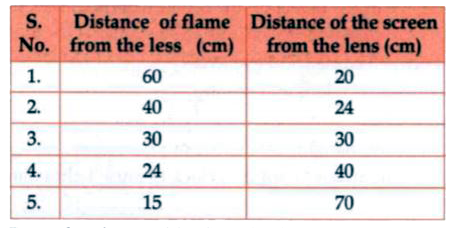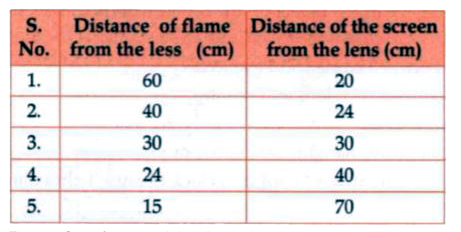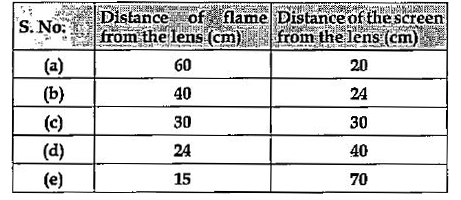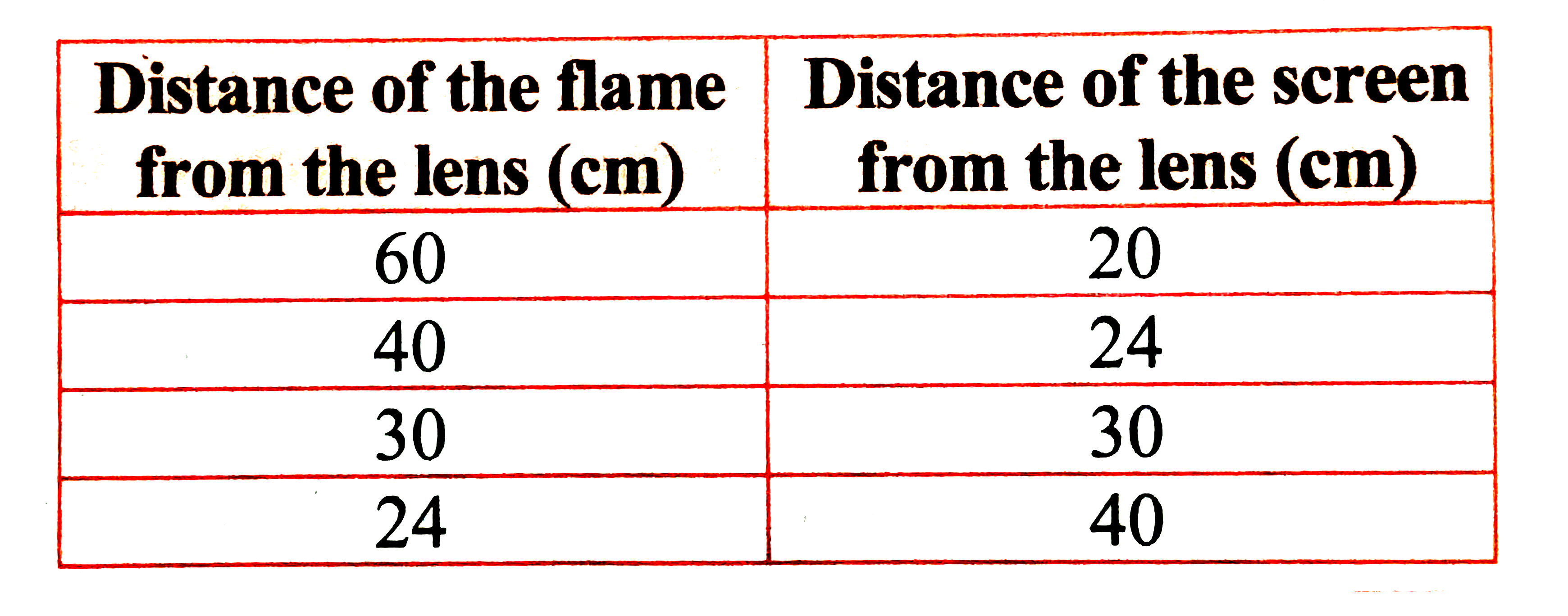Rohit focused the image of a candle flame on a white screen using a convex lens. He noted down the position of the candle, screen and lens as under:
Position of candle = 26.0 cm
Position of convex lens = 50.0 cm
Position of screen=74.0 cm
(i) What is the focal length of the convex lens ?
(ii) Where will the image be formed if he shifts the candle towards the lens at a position of 38 cm ?
(iii) Draw a ray diagram to show the formation of the image in case (ii) as said above?
To solve the problem step by step, we will address each part of the question systematically.
Given Data:
- Position of candle (u) = 26.0 cm (to the left of the lens, so u = -26.0 cm)
- Position of convex lens (focal point not given yet)
- Position of screen (v) = 74.0 cm (to the right of the lens, so v = +74.0 cm)
(i) Finding the Focal Length of the Convex Lens
1. Identify Object Distance (u) and Image Distance (v):
- Object distance (u) = - (Position of candle) = -26.0 cm
- Image distance (v) = (Position of screen) = +74.0 cm
2. Use the Lens Formula:
The lens formula is given by:
1f=1v−1u
3. Substituting the Values:
1f=174−1−26
1f=174+126
4. Finding a Common Denominator:
The least common multiple of 74 and 26 is 962. Therefore:
1f=26+74962=100962
5. Calculating f:
f=962100=9.62 cm
(ii) Finding the Image Position if the Candle is Shifted to 38 cm
1. New Object Distance (u):
- New position of candle = 38.0 cm (to the left of the lens, so u = -38.0 cm)
2. Using the Lens Formula Again:
1f=1v−1u
Substituting the known values:
19.62=1v−1−38
1v=19.62+138
3. Finding a Common Denominator:
The least common multiple of 9.62 and 38 is 365.56. Therefore:
1v=38+9.62365.56=47.62365.56
4. Calculating v:
v≈7.67 cm
(iii) Drawing a Ray Diagram
1. Draw the Convex Lens:
- Draw a horizontal line to represent the principal axis.
- Draw the convex lens at the center.
2. Mark the Focal Points:
- Mark the focal points (F) on both sides of the lens. The distance to the focal point (F) is equal to the focal length calculated (9.62 cm).
3. Place the Object:
- Mark the new position of the candle (object) at 38 cm to the left of the lens.
4. Draw the Rays:
- Draw one ray parallel to the principal axis from the top of the candle. After passing through the lens, this ray will refract and pass through the focal point on the opposite side.
- Draw another ray passing through the optical center of the lens. This ray will continue in a straight line.
5. Locate the Image:
- The intersection of the two refracted rays indicates the position of the image. Since the image distance calculated is approximately 7.67 cm, it will be on the opposite side of the lens.
Summary of Answers:
(i) Focal length of the convex lens = 9.62 cm
(ii) Image will be formed at approximately 7.67 cm on the opposite side of the lens.
(iii) Ray diagram shows the formation of the image as described.
- Position of candle (u) = 26.0 cm (to the left of the lens, so u = -26.0 cm)
- Position of convex lens (focal point not given yet)
- Position of screen (v) = 74.0 cm (to the right of the lens, so v = +74.0 cm)
- Object distance (u) = - (Position of candle) = -26.0 cm
- Image distance (v) = (Position of screen) = +74.0 cm
The lens formula is given by:
1f=1v−1u
1f=174−1−26
1f=174+126
The least common multiple of 74 and 26 is 962. Therefore:
1f=26+74962=100962
f=962100=9.62 cm
- New position of candle = 38.0 cm (to the left of the lens, so u = -38.0 cm)
1f=1v−1u
Substituting the known values:
19.62=1v−1−38
1v=19.62+138
The least common multiple of 9.62 and 38 is 365.56. Therefore:
1v=38+9.62365.56=47.62365.56
v≈7.67 cm
- Draw a horizontal line to represent the principal axis.
- Draw the convex lens at the center.
- Mark the focal points (F) on both sides of the lens. The distance to the focal point (F) is equal to the focal length calculated (9.62 cm).
- Mark the new position of the candle (object) at 38 cm to the left of the lens.
- Draw one ray parallel to the principal axis from the top of the candle. After passing through the lens, this ray will refract and pass through the focal point on the opposite side.
- Draw another ray passing through the optical center of the lens. This ray will continue in a straight line.
- The intersection of the two refracted rays indicates the position of the image. Since the image distance calculated is approximately 7.67 cm, it will be on the opposite side of the lens.
(i) Focal length of the convex lens = 9.62 cm
(ii) Image will be formed at approximately 7.67 cm on the opposite side of the lens.
(iii) Ray diagram shows the formation of the image as described.
Similar Questions
A student focussed the image of a candle flame on a white screen using a convex lens. He noted down the position of the candle, screen and the lens as under
Position of candle =12.0cm
Position of convex lens =50.0cm
Position of the screen =88.0cm
(i) What is the focal length of the convex lens ?
(ii) Where will the image be formed if he shifts the candle towards the lens at a position of 31.0cm.
(iii) What will be the nature of the image formed if he further shifts the candle towards the lens ?
(iv) Draw a ray diagram to show the formation of the image in case (iii) as said above.
View SolutionA student focussed the image of a candle flame on a white screen using a convex lens. He noted down the positive of the candle, screen and the lens as under.
Position of candle = 12.0 cm
Position of the screen = 50.0 cm
Position of the screen = 88.0 cm
(i) What is the focal length of the convex lens ?
(ii) Where will the image be formed if he shifts the candle towards the lens at a position of 31.0 cm ?
(iii) What will be the nature of the image formed if the further shifts the candle towards the lens ?
(iv) Draw a ray diagram to show the formation of the image in case (iii) as said above .
View Solution
Knowledge Check
A student focussed the image of a candle flame on a white screen by placing the flame at various distances from a convex lens. He noted his observations as :

What type of lens is a convex lens?ADiverging lensBConverging lensCFlat lensDNon-converging lensA student focussed the image of a candle flame on a white screen by placing the flame at various distances from a convex lens. He noted his observations as :

Which set of observations is incorrect?Au = 60 cm, v = 20 cmBu = 15 cm, v = 70 cmCu = 30 cm, v= 30 cmDu = 24 cm, v = 40 cmA student focussed the image of a candle flame on a white screen by placing the flame at various distances from a convex lens. He noted his observations as:

Which set of observations is incorrect?Aa)Bc)Ce)Dd)
Rohit focussed the image of a candle flame on a white screen using a convex lens. He noted position of candle =26.0cm, position of convex lens =50.0cm and position of screen =74.0cm.
(i) What is focal length of convex lens?
(ii) Where will the image be formed if he shifts the candle towards the lens at a position of 38 cm ?
(iii) Draw a ray diagram to show the formation of image in (ii) above.
View SolutionA student focused the image of a candle flame on a white screen by placing the flame at various distance from a convex lens. He noted his observation as mentioned in the following table.

Analyze the above table and answer the following questions.
What is the focal length of the convex lens?
View SolutionA convex lens of focal length 10.0 cm is placed in contact with a convex lens of 15.0 cm focal length. What is the focal length of the combination ?
View SolutionA student focussed the image of a candle flame on a white screen by placing the flame at various distances from a convex lens. He noted his observations as:

Which of the following statement is false for the formation of images by convex lens?
View SolutionA student obtains a blurred image of a distant object on a screen using a convex lens. To obtain a distinct image on the screen he should move the lens
View Solution